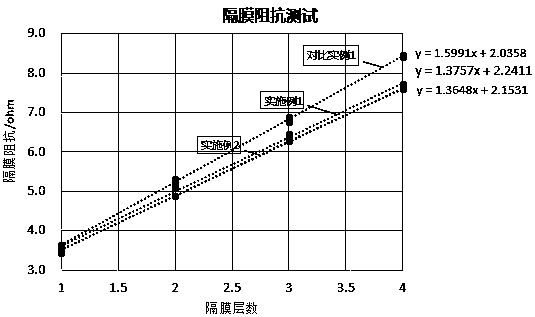Ceramic diaphragm and preparation method thereof
A ceramic diaphragm and diaphragm technology, applied in the field of lithium-ion batteries, can solve the problems of not fundamentally solving the dispersion of ceramics, failing to meet functional requirements, reducing the grafting rate of ceramics, etc., achieving excellent lithium ion conductivity, Improve wettability and improve the effect of easy agglomeration
- Summary
- Abstract
- Description
- Claims
- Application Information
AI Technical Summary
Problems solved by technology
Method used
Image
Examples
Embodiment 1
[0047] Further, the catalyst 1 is a basic amine compound, preferably triethylamine (TEA) in Examples 1 and 2, and further, the halogenated acid halide compound is 2-bromoisobutyryl One or more mixtures in bromine, 2-chloropropionyl chloride, 2-rustanoyl bromide; preferred 2-bromoisobutyryl bromide in this embodiment 1 and embodiment 2;
[0048] Further, the halogen initiator is a halogen functional group such as -Cl or -Br. Correspondingly, in this embodiment 1 and embodiment 2, the initiator is -Br; the halogen initiator can initiate controllable active polymerization, which is different from The general free radical polymerization reaction can realize the designability and controllability of the coating of ceramic powder.
[0049] Further, the catalyst 2 is one of cuprous bromide and cuprous chloride, preferably cuprous bromide in the present embodiment 1 and embodiment 2;
[0050] Further, the catalyst 2 is a cuprous salt compound, which needs to be purified by acidic wate...
Embodiment 2
[0064] In this example, on the basis of Example 1, the ratio of the monomer sodium styrene sulfonate and polyethylene glycol monoacrylic ester is adjusted. Specifically, the steps of the preparation method are the same as in Example 1, except that step 3 The amount of monomer sodium styrene sulfonate and polyethylene glycol monoacrylic ester in the medium. In this example, the amount of monomer sodium styrene sulfonate and ligand pentamethyldiethylenetriamine (PMDETA) is the same as that in Example 1, while polyethylene glycol monomethacrylate ( PEGMA) was increased by 50%.
PUM
| Property | Measurement | Unit |
|---|---|---|
| particle diameter | aaaaa | aaaaa |
| particle diameter | aaaaa | aaaaa |
| thickness | aaaaa | aaaaa |
Abstract
Description
Claims
Application Information
 Login to View More
Login to View More - R&D
- Intellectual Property
- Life Sciences
- Materials
- Tech Scout
- Unparalleled Data Quality
- Higher Quality Content
- 60% Fewer Hallucinations
Browse by: Latest US Patents, China's latest patents, Technical Efficacy Thesaurus, Application Domain, Technology Topic, Popular Technical Reports.
© 2025 PatSnap. All rights reserved.Legal|Privacy policy|Modern Slavery Act Transparency Statement|Sitemap|About US| Contact US: help@patsnap.com



